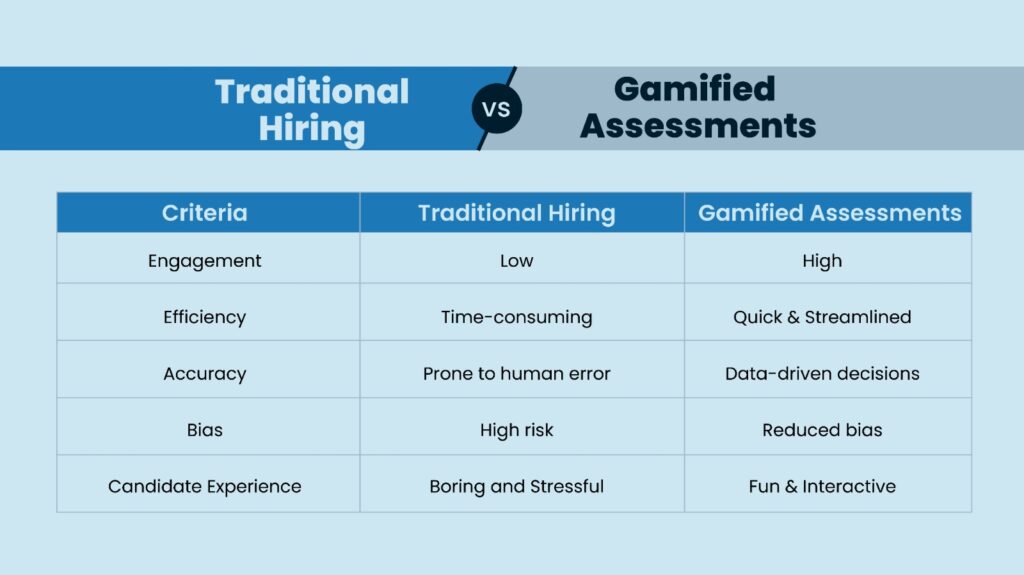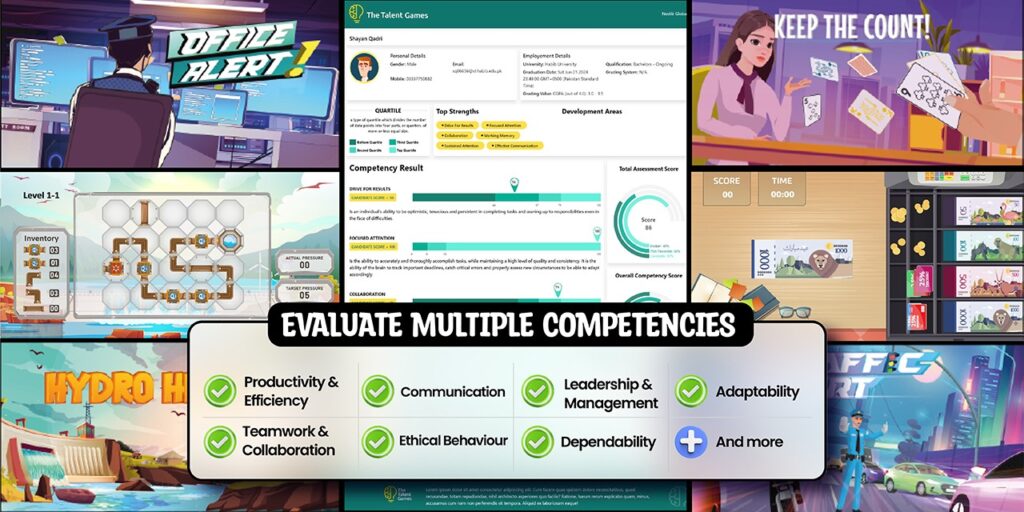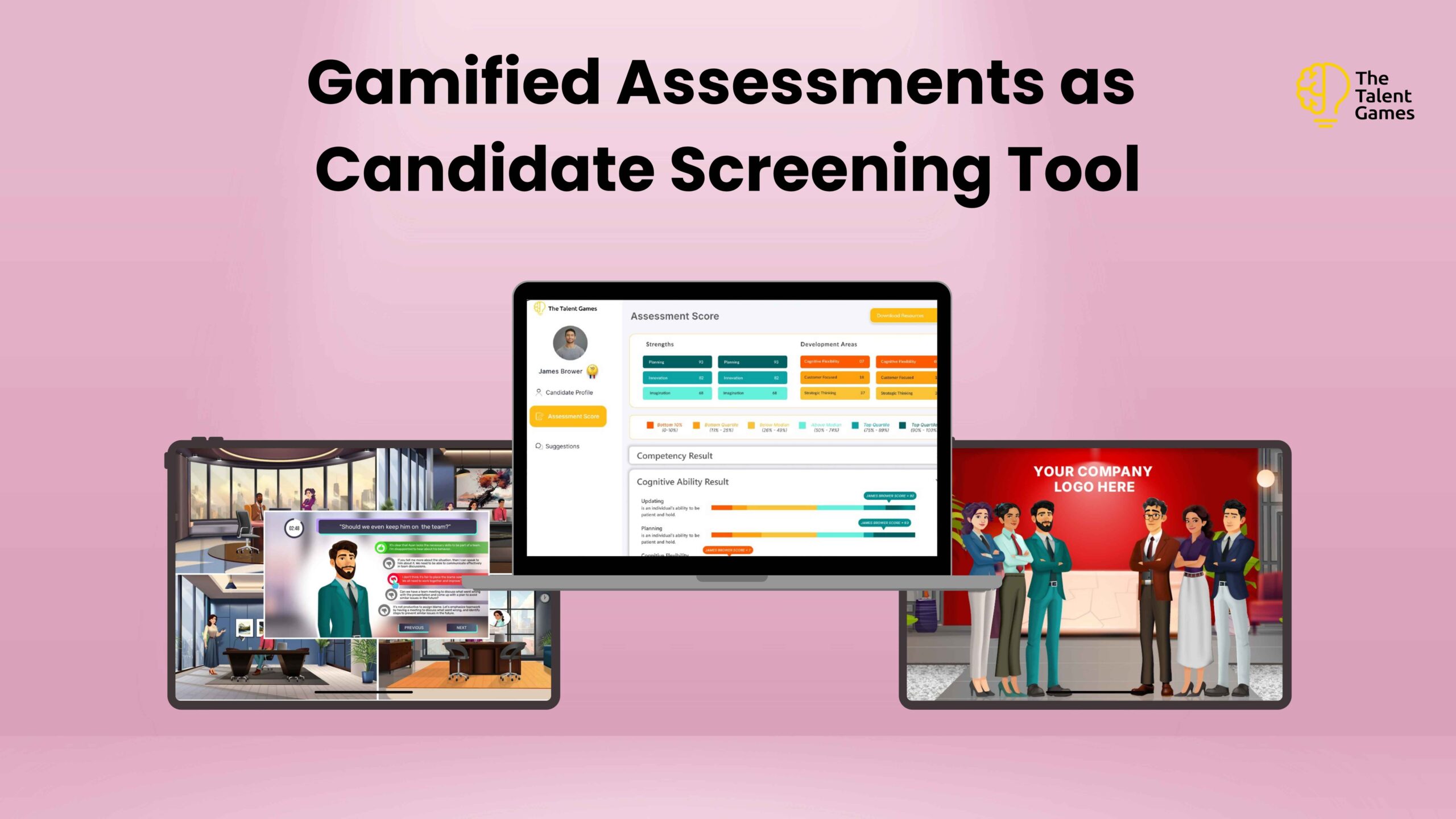Gamified assessments are changing the way companies hire, making them a powerful candidate screening tool for modern recruitment to deal with the ongoing global talent shortage.
Simply put, gamification means using game-like elements, such as challenges, points, and rewards, to make the hiring process more interactive and engaging.
Instead of the usual, boring assessments, gamified assessments offer a fun and dynamic way for candidates to showcase their skills. This approach helps recruiters get a clearer picture of a candidate’s abilities, problem-solving skills, and personality in real time, all while making the experience enjoyable.
Research states that current recruitment trends do not allow millennials to find flexibility and opportunities to portray their skills to their fullest potential.
In this blog, we’ll explain what gamified or game-based assessments are and how they can help your organization attract and identify the best talent in a competitive job market.
What is a Gamified Assessment? Definition & Examples
A gamified assessment is a modern recruitment tool that combines gaming elements such as scoring, levels, and challenges with traditional assessment methods. Organizations use gamified assessments to evaluate skills, behaviors, and personality traits while keeping the candidate experience engaging and scientifically validated.
For instance, a gamified assessment might include situational judgment tests with problem solving tasks, decision making challenges, or teamwork activities. This format allows recruiters to observe how candidates react under pressure, handle challenges, and make decisions in a more interactive environment.
By adopting gamified assessments, employers gain deeper insights into a candidate’s abilities, motivation, and potential. Candidates also enjoy the process more, which leads to a positive impression of the employer brand and an improved hiring experience.
Gamified Assessments as a Candidate Screening Tool
Use of gamified assessment as a candidate screening tool helps organizations to significantly improve their talent selection, analyze candidates through cognitive and behavioral assessments, and also enhance the value of the company as an employer brand.
Reduces Time Spent on Candidate Screening
It saves a lot of time, as then the recruiters won’t have to sift through never-ending pools of resumes. Time is an invaluable asset and gamification saves you alot.
Enhances Candidate and Recruiter Engagement
The process is much more playful. So, a recruiter as well as the candidate can have more fun in the whole candidate screening process because it eliminates monotony.
Delivers Objective and Unbiased Candidate Evaluation
Screening and evaluating candidates becomes free of bias and thus the results are objective. The use of psychometric games provide accurate results to the recruiters to decide objectively.
Gamified Assessments Minimize Candidate Stress
Nerves will not play tricks and will not be influenced by the pressure of the environment. It is intended to obtain continuous feedback without the need to subject the candidate to stress.
Enhances the Recruitment Process with Modern Technology
In addition, it will improve the recruitment and selection processes and open an opportunity to adapt to new technologies. This type of recruitment is known as 3.0 recruitment.
Organizations must know how to distinguish the role of the game. The game should serve to anticipate future behaviors. In addition, it helps to predict the hidden talents of the candidates. You don’t just have to keep ad-hoc games in mind; there are companies that are using games like the famous Clue as a candidate screening tool.
Candidates can experience a process that is innovative, interactive, attractive and educational, which favors in terms of business culture. Candidates are not prepared for such an assessment, and this way, their instincts and attitudes cannot be hidden.

How to Use Game-based Assessments in Candidate Screening Process
Let’s now point out some gamification techniques that make up for a better candidate prescreening process:
Leverage Online Networking for Global Reach
One of the excellent strategies of gamification is the creation of virtual networking spaces. A solution that makes flexible the presence of candidates and talents from virtually anywhere in the world. An easy option to design and that does not require a substantial investment by companies, and that is also an instrumental and necessary technique today, due to globalization.
Utilize Progress Bars to Track Candidate Advancement
Another key to gamification strategies is the ability to show user progress. For this, the progress bars play an essential role. It helps candidates to focus on the objectives and raise the level of effort. Progress bars provide rapid visual feedback of the task performed and help to involve/motivate candidates to achieve their ultimate goal.
Implement Leaderboards for Competitive Evaluation
Given the new selection processes, include a classification table with predefined objectives and tasks and score sheets, making it much easier to identify the best candidates, which have higher scores. It is also a good “instrument” for tracking the progress.
Incorporate Puzzles to Assess Candidate Competencies
These games have become a reference within the gamification of the personnel selection. They are highly effective and help to understand the competencies of the candidates and how they dissolve the mental blocks in their minds.
Offer Rewards to Motivate Candidate Participation
Rewards are another critical factor in gamification. They are quite useful to encourage candidates to participate and be part of the candidate assessment process. Such rewards can be monetary, travel, flexible schedules, etc. Even these rewards can be adapted to each type of employee according to their tastes.
Customize Formats to Suit Different Roles
As gamification allows for greater customization of the candidate screening process for hiring, the game must be adapted to work needs. A space vision game may not work for an editor, but it does apply to an architect or engineer. It is possible to use various means of gamification, such as quizzes, treasure searches, video games, design challenges or coding challenges. Of course, the possibilities offered by this system are virtually endless.
Create a Fun and Engaging Screening Experience
By 2025, 75% of workforce would be millennials. Having said that, use of gamified assessment as an online candidate screening tool becomes attractive, and candidates are tempted to participate. In this way, a greater feeling of belonging to the company is achieved, which is a very positive feature for both the employer and the employee.

Companies Using Gamified Assessments as Candidate Screening Tool
Nestlé (Food and Beverage)
Nestlé has successfully integrated gamified assessments into its graduate recruitment program, leveraging The Talent Games’ innovative solutions for years. This approach not only enhances candidate engagement but also helps the company identify top talent effectively.
Global Football Organization (Sports)
The Global Football Organization utilized job-specific gamified assessments to evaluate over 20,000 volunteers for the major global event in Qatar in 2022. This strategy ensured they selected the most suitable candidates for various roles during the event.
Bupa Health Care (Healthcare)
Bupa Health Care has adopted gamified assessments to assess candidates for their One Bupa Talent program. This method allows them to evaluate applicants’ skills and fit in a more engaging way.
Banglalink (Telecom)
In the telecom industry, Banglalink employs a customized game creation portal for hiring candidates, enhancing the candidate experience while assessing their abilities effectively.
HBL (Bank and Finance)
HBL (Habib Bank Limited) uses customized game-based and gamified assessments for their cashier program, streamlining the selection process and ensuring they attract the right talent.
These examples illustrate how leading organizations across various industries are harnessing gamified assessments as powerful tools in their recruitment strategies, with many others following suit.
In the game, you can enhance more excellent knowledge of the structure of the company. In this way, the chosen candidate does not take this by surprise on the first day of work, which is what happens more often than not.
Gamification in Recruitment: How to make the shift?
To successfully implement gamification in your recruitment strategy, it’s crucial to understand its impact on the selection process. This transition requires organization-wide awareness of the significance of gamification and its potential benefits.
Understanding the Importance of Gamification
To successfully integrate gamification into your recruitment process, it’s essential to ensure that the entire organization understands the significance of the selection process and the pivotal role gamification will play. This isn’t merely a game; it’s a serious strategy that can impact the economic viability of your company.
Building a Strong HR Department
A strong and highly valued Human Resources Department is vital for enhancing a company’s future solvency and overall success. Investing in HR will help you attract and retain top talent, ultimately driving your organization’s growth.
Aligning Gamified Assessments with Job Vacancies
When implementing gamified assessments, it’s crucial that the game aligns with the specific vacancy being filled. Clearly defined objectives and game mechanics are necessary, which requires collaboration among all departments to ensure relevance and effectiveness.
Avoiding Pitfalls of Poor Implementation
While gamification can revolutionize recruitment, poor implementation can lead to disaster, rendering the candidate screening process ineffective and monotonous. Prioritizing thoughtful integration and cross-departmental cooperation will maximize the benefits of gamification in your recruitment strategy.
While it is important to make the game engaging by making it competitive and thrilling – it is also very important to assess if the candidate is a team player in the gamified simulation. Otherwise, we’d only be weighing candidates on a few certain aspects while abandoning other important factors, which in turn would result in failure of the candidate-screening tool for recruitment and selection.
The online candidate screening game should pertain to the business industry that it is built for. If the game is built to screen candidates to manage a production plant, more focus should be there of teamwork and synergies. The candidate should be assessed on how smoothly he keeps the optimal development of the production process while creating a pleasant office environment.
This does not mean that circumstantial aspects of the work environment are not valued, such as the desire to excel and other elements, but that it has to be constricted to clear purposes and not to analyze subjective values.
Do not turn the game into something impersonal, but something with a warm and human side. Although one of the significant advantages of gamification is the objectification of the candidate’s talents and downplaying the subjective nuances.
Final Words
Gamification will allow opening the doors of a company to more creative professionals and collaborators than those with excessively technical profiles and with little social skills.
The use of gamified or game-based assessments as a candidate screening tool helps organizations attract a candidate from the future, with specialized capabilities, without an excess of competitiveness and to keep necessary social skills intact.
